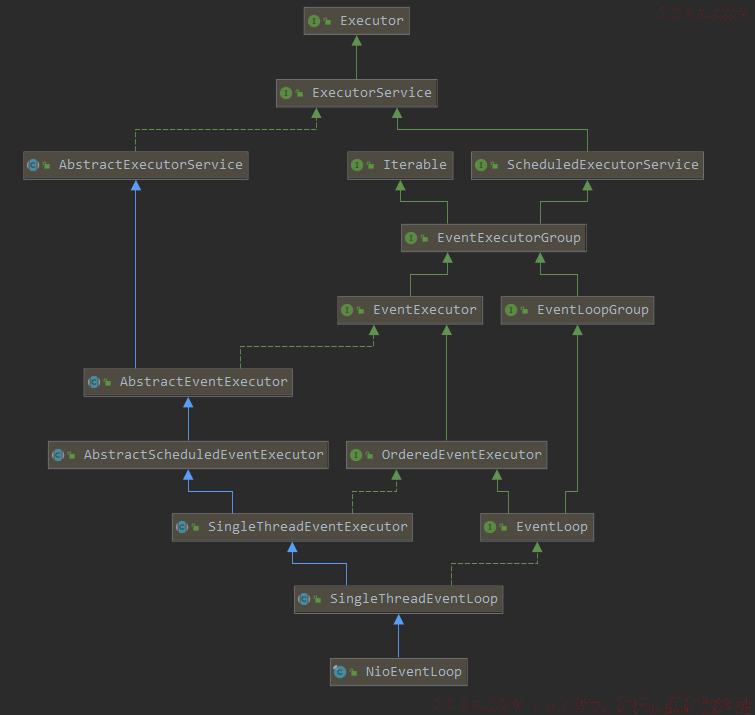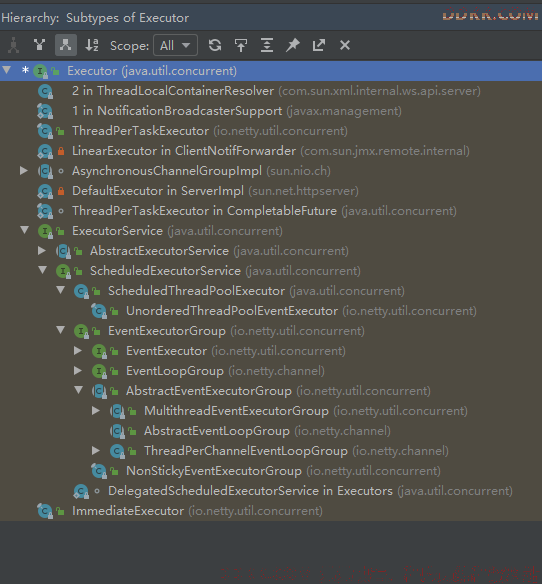41、Netty 源码解析 - EventLoop源码剖析
一、基本说明
分析:EventLoopGroup bossGroup = new NioEventLoopGroup(1);
二、源码剖析
2.1 NioEventLoop 继承图

1、ScheduledExecutorService 接口表示是一个定时任务接口,EventLoop 可以接受定时任务。
2、EventLoop 接口,Netty 接口文档中说明该接口作用:一旦 Channl 注册了,就处理该 Channel 对应的所有 I/O 操作。
3、SingleThreadEventExecutor 表示这是一个单个线程的线程池。
4、EventLoop 是一个单例的线程池,里面含有一个死循环的线程不断的做着 3 件事情:监听端口、处理端口事件、处理队列事件。每个 EventLoop 都可以绑定多个 Channel ,而每个 Channel 始终只能由一个 EventLoop 来处理。
2.2 NioEventLoop的使用 – execute 方法

2.2.1 execute方法
在EventLoop 的使用,一般就是 eventLoop.execute(task); 基于 SingleThreadEventExecutor 的实现:
@Override
public void execute(Runnable task) {
if (task == null) {
throw new NullPointerException("task");
}
boolean inEventLoop = inEventLoop();
if (inEventLoop) {
addTask(task);
} else {
startThread();
addTask(task);
if (isShutdown() && removeTask(task)) {
reject();
}
}
if (!addTaskWakesUp && wakesUpForTask(task)) {
wakeup(inEventLoop);
}
}
1、首先判断该 EventLoop 的线程是否是当前线程,如果是,直接添加到任务队列中去,如果不是,则尝试启动线程(但由于线程是单个的,因此只能启动一次),随后再将任务添加到任务队列中。
2、如果线程已经停止,并且删除任务失败,则执行拒绝策略,默认是抛出异常。
3、如果 addTaskWakesUp 是false,并且任务不是 NonWakeupRunnable 类型的,就尝试唤醒 selector。这个时候,阻塞在 selector 的线程就会立即返回。
2.2.2 addTask、offerTask
protected void addTask(Runnable task) {
if (task == null) {
throw new NullPointerException("task");
}
if (!offerTask(task)) {
reject(task);
}
}
final boolean offerTask(Runnable task) {
if (isShutdown()) {
reject();
}
return taskQueue.offer(task);
}
2.2.3 startThread 方法
1、当执行 execute 方法的时候,如果当前线程不是 EventLoop 所属线程,则尝试启动线程,也就是 startThread 方法,代码如下:
private void startThread() {
if (state == ST_NOT_STARTED) {
if (STATE_UPDATER.compareAndSet(this, ST_NOT_STARTED, ST_STARTED)) {
try {
doStartThread();
} catch (Throwable cause) {
STATE_UPDATER.set(this, ST_NOT_STARTED);
PlatformDependent.throwException(cause);
}
}
}
}
该方法首先判断是否启动过了,保证 EventLoop 只有一个线程,如果没有启动过,则尝试使用 Cas 将 state 状态改为 ST_STARTED,也就是已经启动。然后调用 doStartThread 方法。如果失败,则进行回滚
2)doStartThread 方法,代码如下:
private void doStartThread() {
assert thread == null;
executor.execute(new Runnable() {
@Override
public void run() {
thread = Thread.currentThread();
if (interrupted) {
thread.interrupt();
}
boolean success = false;
updateLastExecutionTime();
try {
SingleThreadEventExecutor.this.run();
success = true;
} catch (Throwable t) {
logger.warn("Unexpected exception from an event executor: ", t);
} finally {
for (;;) {
int oldState = state;
if (oldState >= ST_SHUTTING_DOWN || STATE_UPDATER.compareAndSet(
SingleThreadEventExecutor.this, oldState, ST_SHUTTING_DOWN)) {
break;
}
}
// Check if confirmShutdown() was called at the end of the loop.
if (success && gracefulShutdownStartTime == 0) {
logger.error("Buggy " + EventExecutor.class.getSimpleName() + " implementation; " +
SingleThreadEventExecutor.class.getSimpleName() + ".confirmShutdown() must be called " +
"before run() implementation terminates.");
}
try {
// Run all remaining tasks and shutdown hooks.
for (;;) {
if (confirmShutdown()) {
break;
}
}
} finally {
try {
cleanup();
} finally {
STATE_UPDATER.set(SingleThreadEventExecutor.this, ST_TERMINATED);
threadLock.release();
if (!taskQueue.isEmpty()) {
logger.warn(
"An event executor terminated with " +
"non-empty task queue (" + taskQueue.size() + ')');
}
terminationFuture.setSuccess(null);
}
}
}
}
});
}
- 首先调用 executor 的 execute 方法,这个 executor 就是在创建 EventLoopGroup 的时候创建的 ThreadPerTaskExecutor 类。该 execute 方法会将 Runnable 包装成 Netty 的 FastThreadLocalThread。
- 任务中,首先判断线程中断状态,然后设置最后一次的执行时间。
- 执行当前 NioEventLoop 的 run 方法,注意:这个方法是个死循环,是整个 EventLoop 的核心
- 在 finally 块中,使用 CAS 不断修改 state 状态,改为 ST_SHUTTING_DOWN。也就是当线程 Loop 结束的时候,关闭线程。最后还要死循环确认是否关闭,否则不会break。然后,执行 cleanup 操作,更新状态为 ST_TERMINATED,并释放当前线程锁。如果任务队列不是空,则打印队列中还有多少个未完成的任务。并回调 terminationFuture 方法
- 其实最核心的就是 EventLoop 自身的 run 方法。
2.2.4 EventLoop 的 run 方法
@Override
protected void run() {
for (;;) {
try {
switch (selectStrategy.calculateStrategy(selectNowSupplier, hasTasks())) {
case SelectStrategy.CONTINUE:
continue;
case SelectStrategy.SELECT:
select(wakenUp.getAndSet(false));
if (wakenUp.get()) {
selector.wakeup();
}
// fall through
default:
}
cancelledKeys = 0;
needsToSelectAgain = false;
final int ioRatio = this.ioRatio;
if (ioRatio == 100) {
try {
processSelectedKeys();
} finally {
// Ensure we always run tasks.
runAllTasks();
}
} else {
final long ioStartTime = System.nanoTime();
try {
processSelectedKeys();
} finally {
// Ensure we always run tasks.
final long ioTime = System.nanoTime() - ioStartTime;
runAllTasks(ioTime * (100 - ioRatio) / ioRatio);
}
}
} catch (Throwable t) {
handleLoopException(t);
}
// Always handle shutdown even if the loop processing threw an exception.
try {
if (isShuttingDown()) {
closeAll();
if (confirmShutdown()) {
return;
}
}
} catch (Throwable t) {
handleLoopException(t);
}
}
}
1、从上面的步骤可以看出,整个 run 方法做了三件事情
- select 获取感兴趣的事情
- processSelectedKeys 处理事件
- runAllTasks 执行队列中的任务
2、select 方法(体现非阻塞)
private void select(boolean oldWakenUp) throws IOException {
Selector selector = this.selector;
try {
int selectCnt = 0;
long currentTimeNanos = System.nanoTime();
long selectDeadLineNanos = currentTimeNanos + delayNanos(currentTimeNanos);
for (;;) {
long timeoutMillis = (selectDeadLineNanos - currentTimeNanos + 500000L) / 1000000L;
if (timeoutMillis <= 0) {
if (selectCnt == 0) {
selector.selectNow();
selectCnt = 1;
}
break;
}
// If a task was submitted when wakenUp value was true, the task didn't get a chance to call
// Selector#wakeup. So we need to check task queue again before executing select operation.
// If we don't, the task might be pended until select operation was timed out.
// It might be pended until idle timeout if IdleStateHandler existed in pipeline.
if (hasTasks() && wakenUp.compareAndSet(false, true)) {
selector.selectNow();
selectCnt = 1;
break;
}
int selectedKeys = selector.select(timeoutMillis);
selectCnt ++;
if (selectedKeys != 0 || oldWakenUp || wakenUp.get() || hasTasks() || hasScheduledTasks()) {
// - Selected something,
// - waken up by user, or
// - the task queue has a pending task.
// - a scheduled task is ready for processing
break;
}
if (Thread.interrupted()) {
// Thread was interrupted so reset selected keys and break so we not run into a busy loop.
// As this is most likely a bug in the handler of the user or it's client library we will
// also log it.
//
// See https://github.com/netty/netty/issues/2426
if (logger.isDebugEnabled()) {
logger.debug("Selector.select() returned prematurely because " +
"Thread.currentThread().interrupt() was called. Use " +
"NioEventLoop.shutdownGracefully() to shutdown the NioEventLoop.");
}
selectCnt = 1;
break;
}
long time = System.nanoTime();
if (time - TimeUnit.MILLISECONDS.toNanos(timeoutMillis) >= currentTimeNanos) {
// timeoutMillis elapsed without anything selected.
selectCnt = 1;
} else if (SELECTOR_AUTO_REBUILD_THRESHOLD > 0 &&
selectCnt >= SELECTOR_AUTO_REBUILD_THRESHOLD) {
// The selector returned prematurely many times in a row.
// Rebuild the selector to work around the problem.
logger.warn(
"Selector.select() returned prematurely {} times in a row; rebuilding Selector {}.",
selectCnt, selector);
rebuildSelector();
selector = this.selector;
// Select again to populate selectedKeys.
selector.selectNow();
selectCnt = 1;
break;
}
currentTimeNanos = time;
}
if (selectCnt > MIN_PREMATURE_SELECTOR_RETURNS) {
if (logger.isDebugEnabled()) {
logger.debug("Selector.select() returned prematurely {} times in a row for Selector {}.",
selectCnt - 1, selector);
}
}
} catch (CancelledKeyException e) {
if (logger.isDebugEnabled()) {
logger.debug(CancelledKeyException.class.getSimpleName() + " raised by a Selector {} - JDK bug?",
selector, e);
}
// Harmless exception - log anyway
}
}
调用selector 的 select 方法,默认阻塞一秒钟,如果有定时任务,则在定时任务剩余时间的基础上加上 0.5 秒进行阻塞。当执行 execute 方法的时候,也就是添加任务的时候,唤醒 selector ,防止 selector 阻塞时间过长。
三、总结
每次执行 execute 方法都是向队列中添加任务。当第一次添加时就启动线程,执行 run 方法,而 run 方法是整个 EventLoop 的核心,就像 EventLoop 的名字一样,Loop,Loop 完成以下 3件事情:
- 调用 selector 的 select 方法,默认阻塞一秒钟,如果有定时任务,则在定时任务剩余时间的基础上在加上0.5秒进行阻塞。当执行 execute 方法的时候,也就是添加任务的时候,会唤醒 selector,防止 selector 阻塞时间过长。
- 当 selector 返回的时候,会调用 processSelectedKeys 方法对 selectedKeys 进行处理。
- 当 processSelectedKeys 方法执行结束后,则按照 ioRatio 的比例执行 runAllTasks 方法,默认 IO 任务时间和非 IO 任务时间是相同的,你也可以根据你的应用特点进行调优。比如 非 IO 任务比较多,那么你就将 ioRatio 调小一点,这样 非 IO 任务就能执行的长一点,防止队列中积攒过多的任务。